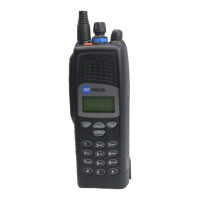TP9100 Service Manual Transmitter Fault Finding 217
© Tait Electronics Limited May 2005
10 Transmitter Fault Finding
Introduction This section covers the diagnosis of faults in the transmitter circuitry.
The main indication of a fault in the transmitter is a reduction in range.
This implies that the power output is wrong or too low. Another type of
fault is manifested when the radio always transmits at full power, even if set
otherwise. Regardless of the fault, the lock status should be normal.
Fault-Diagnosis
Tas ks
The procedure for diagnosing transmitter faults is divided into tasks, which
are grouped into the following sections:
■ “Power Supplies”
■ “Transmitter RF Power”
■ “Biasing of PA Driver and PA”
■ “RF Signal Path”
Before beginning the fault diagnosis with “Power Supplies”, note the
following information regarding CCTM commands, frequency bands, can
removal and replacement, and transmit tests.
CCTM Commands The CCTM commands required in this section are listed in Table 10.1.
Full details of the commands are given in “Computer-Controlled Test
Mode (CCTM)” on page 91.
Table 10.1 CCTM commands required for the diagnosis of faults in the transmitter
Command Description
32
33
803
101 x y 0
114 x
326 x
331
331 x
334 x
335 x
Set radio in receive mode
Set radio in transmit mode
Read temperature near front panel (FPI = x) and PA (TX = y). To convert to °C:
temp = (x or y/-2.37)+160
Set transmit frequency (x in hertz) and receive frequency (y in hertz) to specified values
Set DAC value x (in range 0 to 1023) of transmit power
Set transmitter power level x (0=off, 1=very low, 2=low, 3=medium, 4=high, 5=maximum)
Read bias voltage for first PA — displays DAC value x (in range 0 to 255)
Set DAC value x (in range 0 to 255) of bias voltage for first PA
Set synthesizer on (x=1) or off (x=0) via DIG SYN EN line
Set transmit-receive switch on (x=1) or off (x=0) via DIG SYN TR SW line

